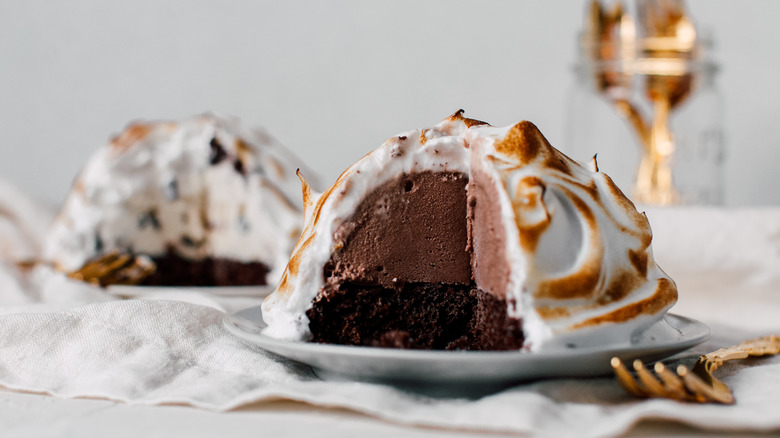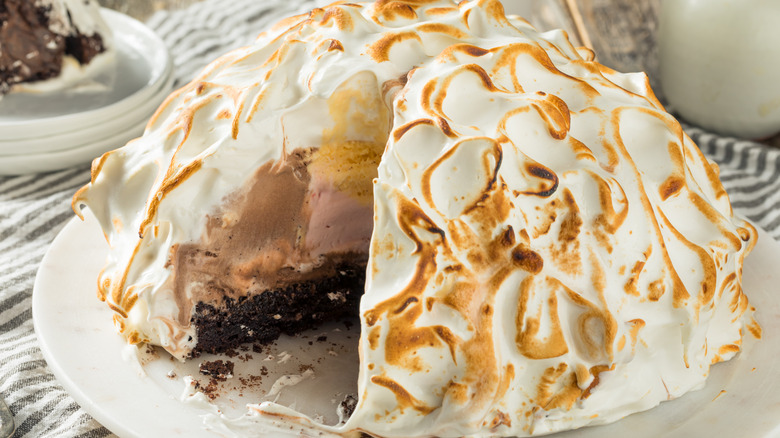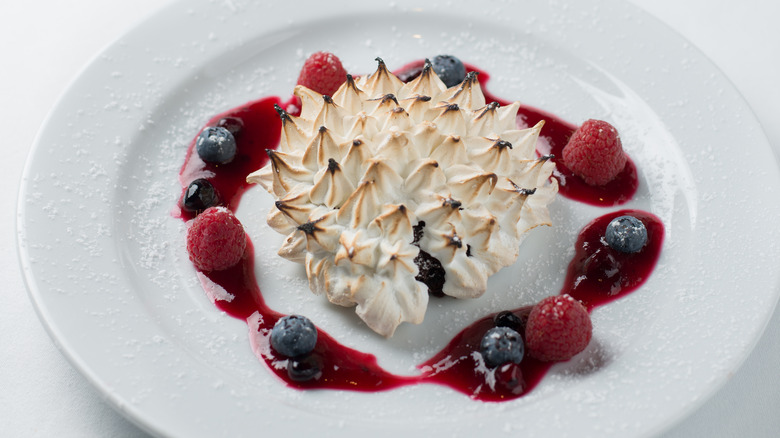Is The Popular Baked Alaska Dessert Actually From Alaska?
Alaska has a lot to offer: 3 million lakes, 12,000 rivers, the biggest car-accessible glacier in the U.S., America's biggest forest, and clear views of the Northern Lights. But do we have The Last Frontier to thank for Baked Alaska? Sort of. If you're unfamiliar with the dessert, Baked Alaska contains a layer of cake, frozen ice cream in the middle, and is topped with toasted meringue. While the dessert is named after the 49th state in the U.S., it did not originate in Alaska.
According to NPR, Baked Alaska provides "a creation story shrouded in mystery." The tale begins with American-born British physicist, Sir Benjamin Thompson, who was also known as Count Rumford, thanks to sticking by the crown during the American Revolution. He chose the name Rumford based on the town in New Hampshire where he got married. The scientist and inventor already created a double boiler, kitchen range, drip coffee pot, and thermal underwear. But it was his realization about egg whites that contributed to the cake and ice cream-based dessert you may know and love today. Rumford noticed the air bubbles that are part of whipped egg whites make meringue an excellent insulator. In other words, it helps the ice cream inside the dessert remain cold. Libby O'Connell, the History Channel's lead historian, who wrote "The American Plate," told NPR "That's really why Baked Alaska works. The meringue insulates the ice cream from heat."
Where did Baked Alaska originate?
In the 19th century, the French used Thompson's discovery to create a dessert they dubbed the "Omelette Norwegge," which allegedly came before Baked Alaska in 1830. However, Michael Krondl, who helped edit "The Oxford Companion to Sugar and Sweets," told NPR that the French dessert named after Norway didn't appear until 1890. Either way, both desserts contain cake and ice cream coated with broiled meringue. They just have different names.
According to NPR, French pastry chef Charles Ranhofer often gets credit for linking the dessert's name with Alaska. While working at Delmonico's restaurant in New York City, the Parisian chef created a dessert that mimicked the French's Omelette Norwegge, which he called "Alaska, Florida" to highlight the juxtaposition between Florida and Alaska. NPR adds that at the time, Secretary of State William Seward took a lot of heat — no pun intended — for buying cold, barren Alaska from Russia for $7.2 million in 1867. Ranhofer's dessert used banana ice cream, walnut spice cake, and meringue on the outside that was torched until it became crispy.
Because the dessert took a long time to make in the 19th century, it was pricey. Libby O'Connell told NPR that "it's one of the best exemplars of the Gilded Age in American history." NPR reports that the dessert would've cost the equivalent of $40 today, and the restaurant where it originated attracted customers like the Rockefellers and Charles Dickens.
Is Baked Alaska popular in Alaska?
Billy Oliva, who was the executive chef at Delmonico's, which is temporarily closed, told NPR that the name Baked Alaska comes from English journalist George Sala, who went to the restaurant and noted, "The 'Alaska' is a baked ice ... the nucleus or core of the entremets is an ice cream ... surrounded by an envelope of carefully whipped cream, which, just before the dainty dish is served, is popped into the oven or brought under the scorching influence of a red hot salamander." Writer Michael Krondl shared that there is not enough proof to determine whether Charles Ranhofer is the one who invented "Alaska, Florida," but NPR notes that Ranhofer featured the desert in his 1894 cookbook "The Epicurean."
Despite conflicting accounts, Baked Alaska is considered one of the oldest desserts in the U.S., and Cathy Kauffman, president of the Culinary Historians of New York, told Thrillist, "Any sort of ice cream dish was considered very, very fashionable. It was on virtually every menu in the late 19th century from anyone who had any pretension" because nobody was making ice cream dishes at home. While the dessert's complex history and name suggest it may be a staple in Alaska, the Anchorage Daily News reports that it is uncommon to find the dessert on most menus throughout Alaska, and currently, "Alaska's namesake dessert is trapped in a dusty 1970s cookbook and can't get out."


